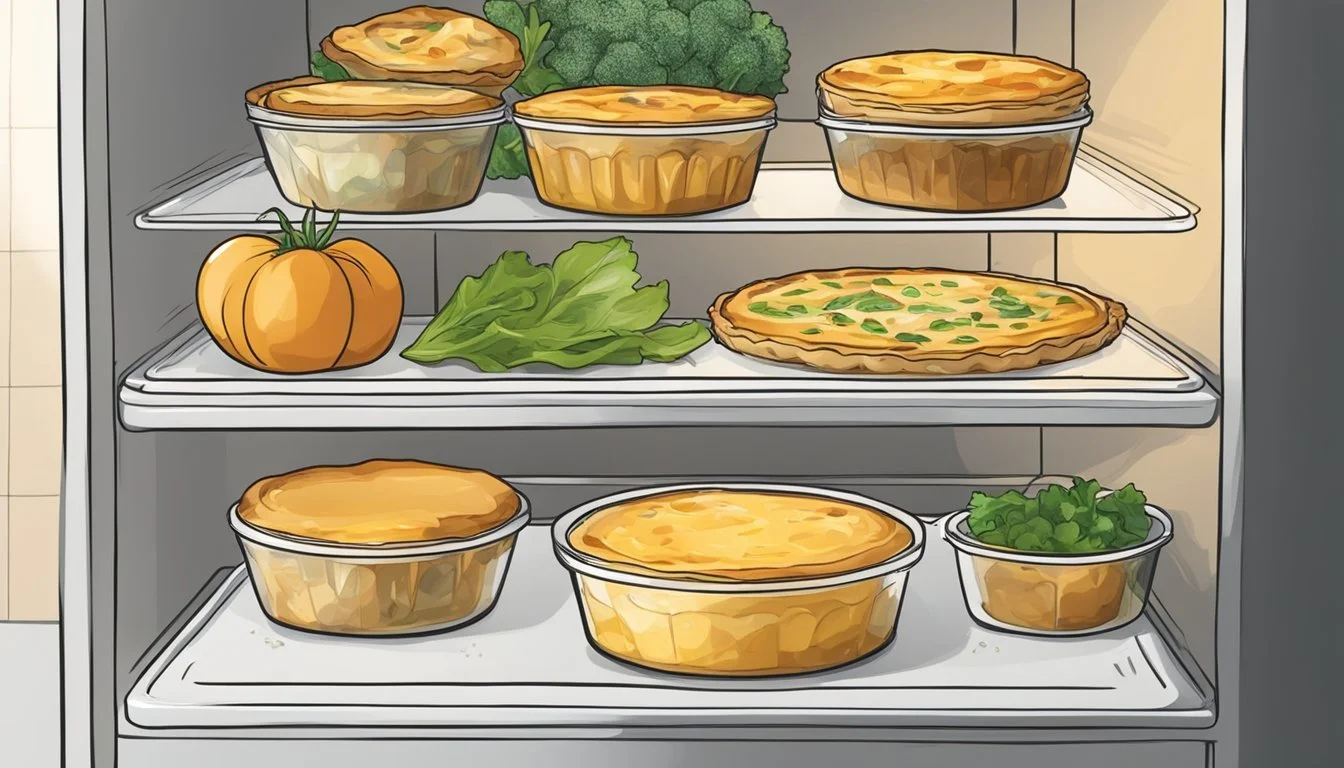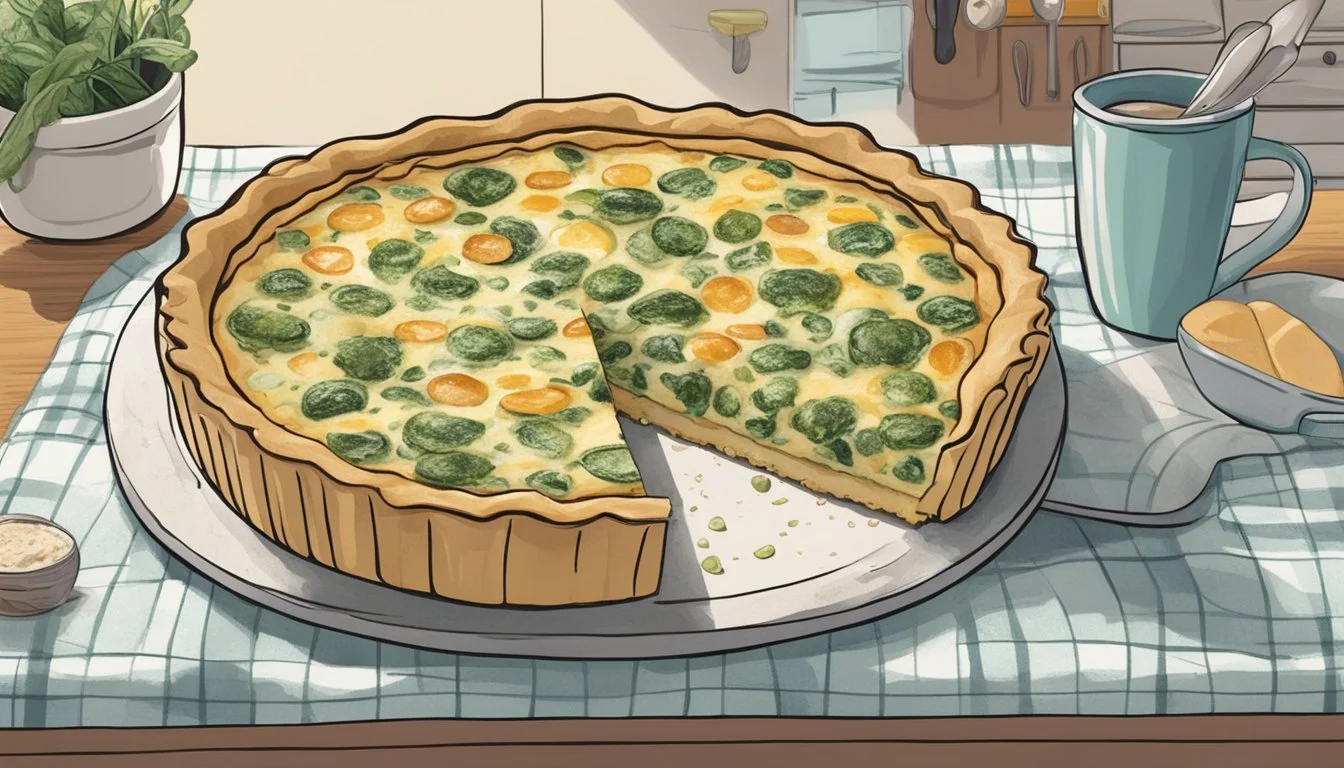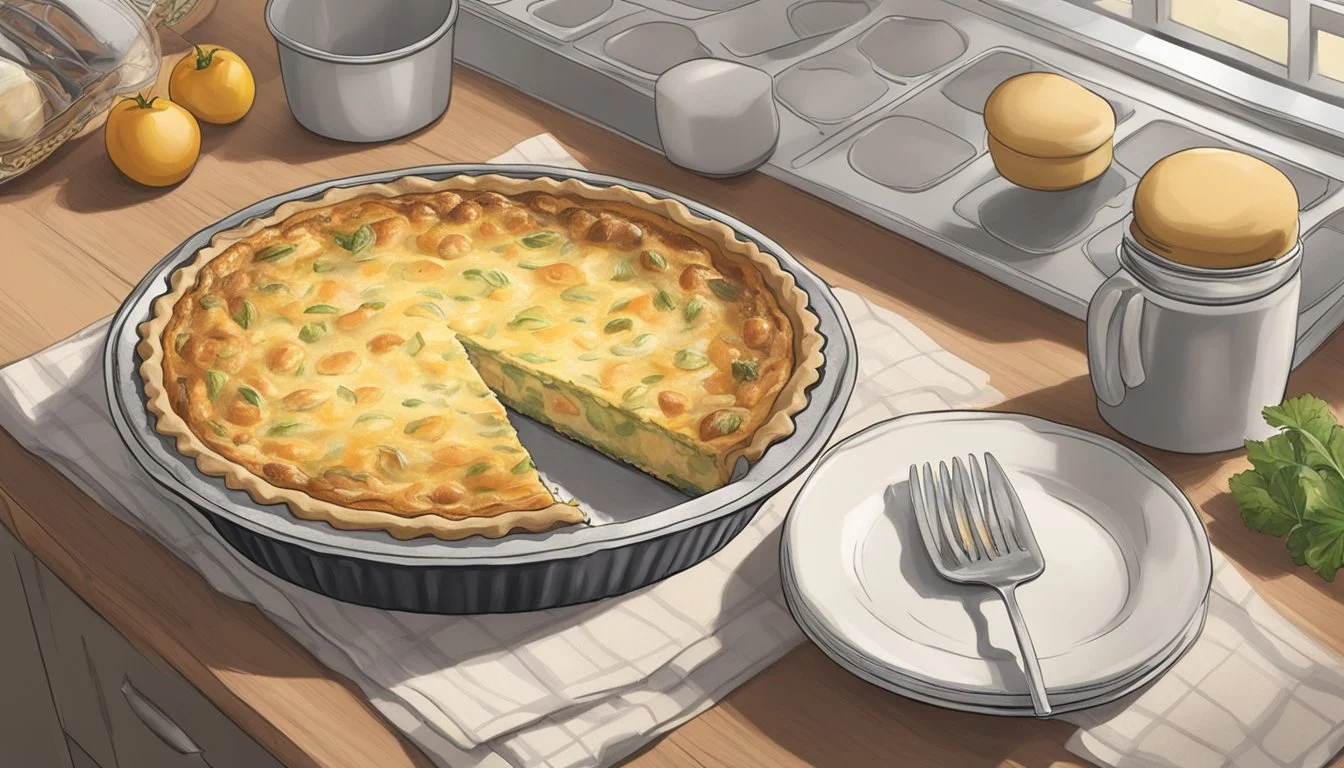How Long Does Quiche Last?
Shelf Life and Storage Tips
Quiche (What wine goes well with quiche?) is a savory dish known for its versatility and rich flavor, typically combining a pastry crust with a filling of eggs, milk or cream, cheese, meat, seafood, or vegetables. The longevity of a quiche depends on several factors including its ingredients, preparation, and how it is stored. Freshly baked quiche can be safely consumed when stored in the refrigerator for up to 3-4 days. However, to ensure the best quality and safety, it should be consumed within this timeframe.
When considering the shelf life of quiche, it is also essential to recognize the potential for freezing this dish. Quiche can be stored in a freezer, where it maintains its quality for 3-4 months when kept at a constant temperature of 0°F. Proper storage is crucial to extending the life of quiche and preventing spoilage. Quiche left at room temperature should be eaten within 1-2 hours to minimize the risk of bacterial growth.
Observing the appearance, texture, and odor of quiche can help identify any signs of spoilage. An expired quiche often exhibits a hard, crusty texture and a dull color, negating its characteristic creamy consistency and vibrant, fresh appearance. If any signs of spoilage are present, it is best to discard the quiche to avoid potential foodborne illness.
Understanding Quiche Shelf Life
When it comes to quiche, understanding its shelf life is crucial for maintaining freshness and ensuring safe consumption. Shelf life can vary based on whether the quiche is homemade or store-bought, and proper storage is key to longevity.
Importance of Expiration Dates
Store-bought quiche often comes with an expiration date, which is indicative of the last day that the product is expected to maintain its quality. Beyond this date, the freshness might begin to decline. Consumers should note that an unopened store-bought quiche can typically last for 3 to 5 days past the sell-by date if kept refrigerated at or below 40°F (4°C).
Factors Affecting Quiche Longevity
Several factors influence the shelf life of quiche:
Storage Temperature: Quiche should be stored in the refrigerator at or below 40°F (4°C).
Storage Method: An airtight container or wrapping tightly in plastic wrap is essential for refrigeration to prevent moisture loss and contamination.
Ingredients: Freshness of the ingredients used in homemade quiche can affect its longevity.
Time at Room Temperature: Quiche should not sit out at room temperature for more than 2 hours to prevent bacterial growth.
In summary, a homemade quiche when stored properly can last about 3 to 4 days in the refrigerator. If a longer storage solution is needed, freezing quiche is acceptable. Properly wrapped and frozen quiche can be kept for 2 to 3 months while preserving its quality.
Storage Methods and Conditions
Proper storage of quiche is crucial to maintain its quality and safety. It's important to understand the different methods and specific conditions that can extend shelf life while protecting the taste and texture of this dish.
Refrigeration Guidelines
Once cooled to room temperature, a quiche should immediately be refrigerated. The refrigerator temperature should consistently maintain 35-40°F to ensure safety. A typical quiche can be expected to last 3-4 days when stored in the refrigerator. Signs of spoilage such as a sour smell or discoloration indicate it is no longer safe to consume.
Freezing and Thawing Procedures
For long-term storage, quiche can be frozen. To freeze quiche, it should be wrapped securely in aluminum foil, plastic wrap, or an airtight container to avoid freezer burn. In the freezer, quiche can last approximately 3-4 months. To thaw, it's recommended to transfer the quiche to the refrigerator and allow it to slowly defrost overnight. Once thawed, consume the quiche within 24 hours for best quality.
Airtight Containers and Wrapping
The use of airtight containers or tightly sealed plastic wrap is essential for storing quiche in both the refrigerator and freezer. This prevents moisture loss, preserves texture, and keeps out contaminants. For best results in the freezer, an initial layer of plastic wrap followed by a layer of aluminum foil can offer optimal protection.
Signs of Spoilage
When assessing if a quiche has gone bad, one must pay attention to specific visual and olfactory cues. These indicators are reliable signs a quiche is no longer safe for consumption.
Visual Indicators
Color: Fresh quiche should have a natural palette appropriate to the ingredients used. Any discoloration, such as a dark or dull appearance, suggests spoilage.
Texture: A good quiche has a consistent and firm texture. Signs of spoilage include a hard, crusty surface or if it appears watery or slimy, indicating bacterial growth.
Olfactory Cues
Smell: Quiche should have a pleasant aroma. A sour smell or a foul odor, reminiscent of rotten eggs, is a clear warning the quiche has spoiled.
Mold: The presence of mold, perceived as musty or mildewy scents, is an unmistakable sign that a quiche should not be consumed.
Food Safety and Health Risks
When considering how long quiche lasts, one must prioritize food safety and the associated health risks. Quiche, typically rich in dairy and eggs, is a perishable item that requires proper handling to minimize the risk of bacterial growth and food poisoning.
Bacterial Growth and Food Poisoning
The risk of bacterial growth in quiche increases when it is kept at temperatures between 40°F and 140°F, a range known as the "danger zone." Pathogens such as Salmonella and Listeria can multiply rapidly at these temperatures. The internal temperature of quiche should be cooked to at least 160°F to ensure any harmful bacteria are destroyed. After cooking, if quiche remains at room temperature for more than 2 hours, the risk of foodborne illness rises significantly.
Key Practices to Prevent Bacterial Growth:
Keep quiche refrigerated below 40°F.
Consume or refrigerate freshly cooked quiche within 2 hours.
Reheat to an internal temperature of 165°F before serving again.
Safe Consumption Practices
Refrigeration is crucial to extending the shelf life of quiche while reducing health risks. Quiche should be stored in the fridge at or below 40°F and should be eaten within 3-4 days to maintain safety and quality. In the freezer, quiche can be safely stored for up to 3-4 months.
Recommendations for Safe Consumption:
Refrigerate Promptly: Store quiche in the refrigerator within 2 hours of cooking or purchase.
Reheat Safely: Ensure the quiche reaches an internal temperature of 165°F before consuming leftovers.
Inspect for Spoilage: Before eating, check for changes in texture, color, or smell that may indicate spoilage.
Preparation and Cooking
Proper preparation and cooking are crucial to ensure the quiche's longevity. The techniques, ingredients, and methods for reheating play a pivotal role in its shelf life.
Baking Techniques
In baking a quiche, one should preheat the oven to an appropriate temperature—often between 350°F to 375°F. It's essential to bake until the egg mixture is set and the crust is golden. A typical quiche may take 35 to 45 minutes in the oven. Over or under-cooking can affect not only the taste and texture but also how well the quiche preserves.
Cooking Times/Temp
Quiche Type Temperature Time Quiche Lorraine 375°F 35-45 minutes Vegetable Quiche 350°F 40-50 minutes Cheese Quiche 350°F 35-45 minutes
Ingredients and Recipe Variations
Quality ingredients are key. Fresh eggs, dairy (milk or cream), and add-ins such as cheese, meat, or vegetables should be used. Recipes can vary; for instance, a Quiche Lorraine traditionally includes lardons or bacon. Other recipes might substitute with alternative meats or feature only vegetables.
Ingredient Variations
Dairy: Creamy texture; use milk or heavy cream.
Cheese: Variety is key, from sharp cheddar to soft goat cheese.
Meat: Bacon in Quiche Lorraine or ham alternatives.
Vegetables: Spinach, mushrooms, or onions commonly added.
Reheating Leftovers
When reheating leftovers, the goal is to restore the original texture without overcooking. An oven or toaster oven is preferable over a microwave to avoid sogginess. Preheat to 350°F and warm the quiche for about 15 to 25 minutes. Reheating time should be adjusted based on the quiche's size and thickness.
Reheating Instructions
Preheat oven to 350°F.
Place quiche on baking sheet.
Heat for 15 to 25 minutes or until thoroughly warm.
Maximizing Quiche Quality
To ensure quiche maintains its optimum quality, careful attention to texture and flavor preservation is essential, as well as managing moisture levels to avoid a soggy crust.
Maintaining Texture and Flavor
Texture and flavor are paramount when it comes to the quality of quiche. It is essential to cool the quiche completely before refrigeration to preserve its delicate custard-like texture. To prevent the crust from becoming soft:
Let the quiche cool on a wire rack, which allows airflow around the crust, keeping it crisp.
Store in an airtight container to protect the crust and texture from absorbing other flavors and odors from the refrigerator.
Additionally, flavor quality is best maintained by:
Using fresh, high-quality ingredients.
Ensuring that the quiche is wrapped tightly in plastic wrap or aluminum foil if not in an airtight container.
Handling Moisture and Humidity
Managing moisture and humidity is crucial in preventing a soggy quiche. Following the correct storage procedures will help control condensation, which can lead to a soggy crust:
To avoid condensation, let the quiche cool thoroughly before you wrap it or place it in a container.
Place a paper towel at the bottom of the storage container to absorb any excess moisture.
Strict control over humidity levels can prevent the formation of a soggy crust and ensure the quiche remains flavorful and with the right texture.
Freezer Storage Tips
Proper storage conditions are crucial to extend the life of quiche in the freezer, preventing texture and flavor loss. When freezing quiche, one should aim to minimize freezer burn and create optimal conditions that preserve the quiche's quality.
Preventing Freezer Burn
Freezer burn occurs when air comes into contact with food surfaces, leading to dehydration and oxidation. To prevent this:
Wrap the quiche tightly with plastic wrap, pressing out as much air as possible.
Use aluminum foil as an additional layer for extra protection.
Ensure quiche is completely cooled before wrapping to avoid condensation, which can contribute to freezer burn.
Optimal Freezing Conditions
For the best results when freezing quiche:
Freeze quiche at 0°F (-18°C) or lower to inhibit bacteria growth and preserve its quality.
Store in an airtight container or a freezer-safe bag to shield from temperature fluctuations.
Label the container with the date and type of quiche to keep track of how long it has been stored.
Quiche can generally be stored in the freezer for up to 3 months without significant changes to flavor or quality.
Serving and Presentation
Properly presenting and serving quiche ensures optimal taste and aesthetic appeal, whether for an everyday breakfast or a special event. This section covers the essential considerations for thawing and portioning, as well as presentation techniques suitable for various occasions.
Thawing and Serving Sizes
Thawing frozen quiche is best done in the refrigerator, allowing it to gently come to a safe and palatable temperature. This process typically takes several hours, so one should plan ahead. For leftover quiche or store-bought options that have been previously frozen, individual slices may be reheated in the oven for a quick and convenient breakfast or snack. Serving sizes generally depend on whether the quiche is the main dish or part of a larger spread. As a main, one should allot a larger slice per person, whereas for multi-dish meals, smaller portions are adequate.
Presentation for Events
When serving quiche at parties or events, presentation plays a crucial role. For an eye-catching display, the host might consider:
Fresh Garnishes: A sprinkle of fresh herbs such as parsley or chives can add a vibrant touch.
Accompanying Sides: A side salad or fresh fruit complements the richness of quiche.
Plating: Serve slices on warm plates to maintain temperature.
Arrangement: Place quiches on a tiered stand for an elegant buffet setup.
For both store-bought and homemade quiches, maintaining the right temperature and a visually appealing setup will enhance the guest's dining experience.
Identifying and Extending Quiche Freshness
When it comes to quiche, knowing the freshness indicators and how to extend its shelf life is essential for both safety and taste.
Shelf-Life Indicators
The freshness of quiche can be gauged by several key indicators. One should inspect:
Color: A fresh quiche should have vibrant, natural colors. A shift towards dull, dark colors can suggest spoilage.
Texture: A spoilage sign is when the normally soft and creamy texture of quiche becomes hard or excessively dry.
Odor: A sour or otherwise unpleasant odor is a clear indicator that the quiche has past its prime.
Touch: Any unexpected sliminess or sticky residue on the quiche's surface can denote spoilage.
For pre-made or store-bought quiche, the expiration date or sell-by date is indicative of freshness, but one can often use the product safely for a short period beyond this date if properly stored and if all other freshness indicators are normal.
Extending Usability Beyond the Sell-By Date
Proper storage is key to extending the usability of quiche beyond its sell-by date. To ensure longevity:
Refrigeration: Quiche should be refrigerated at or below 40°F as soon as possible and consumed within 3-4 days.
Freezing: To further extend a quiche's life, one can freeze it, which will keep it safe for consumption for 3-4 months. Freeze in an airtight container or wrapped securely to maintain quality.
Reheating: When ready to eat, the quiche should be reheated to an internal temperature of 165°F to ensure safety, especially if it has been stored for an extended period.
By adhering to these storage guidelines, the shelf life of quiche can be maximized without compromising safety or taste.









